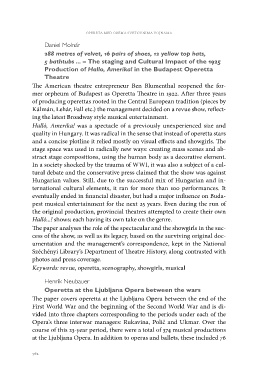Page 564 - Weiss, Jernej, ur./ed. 2021. Opereta med obema svetovnima vojnama ▪︎ Operetta between the Two World Wars. Koper/Ljubljana: Založba Univerze na Primorskem in Festival Ljubljana. Studia musicologica Labacensia, 5
P. 564
opereta med obema svetovnima vojnama
Daniel Molnár
288 metres of velvet, 16 pairs of shoes, 12 yellow top hats,
5 bathtubs ... – The staging and Cultural Impact of the 1925
Production of Hallo, Amerika! in the Budapest Operetta
Theatre
The American theatre entrepreneur Ben Blumenthal reopened the for-
mer orpheum of Budapest as Operetta Theatre in 1922. After three years
of producing operettas rooted in the Central European tradition (pieces by
Kálmán, Lehár, Fall etc.) the management decided on a revue show, reflect-
ing the latest Broadway style musical entertainment.
Halló, Amerika! was a spectacle of a previously unexperienced size and
quality in Hungary. It was radical in the sense that instead of operetta stars
and a concise plotline it relied mostly on visual effects and showgirls. The
stage space was used in radically new ways: creating mass scenes and ab-
stract stage compositions, using the human body as a decorative element.
In a society shocked by the trauma of WWI, it was also a subject of a cul-
tural debate and the conservative press claimed that the show was against
Hungarian values. Still, due to the successful mix of Hungarian and in-
ternational cultural elements, it ran for more than 100 performances. It
eventually ended in financial disaster, but had a major influence on Buda-
pest musical entertainment for the next 25 years. Even during the run of
the original production, provincial theatres attempted to create their own
Halló...! shows; each having its own take on the genre.
The paper analyses the role of the spectacular and the showgirls in the suc-
cess of the show, as well as its legacy, based on the surviving original doc-
umentation and the management’s correspondence, kept in the National
Széchényi Library’s Department of Theatre History, along contrasted with
photos and press coverage.
Keywords: revue, operetta, scenography, showgirls, musical
Henrik Neubauer
Operetta at the Ljubljana Opera between the wars
The paper covers operetta at the Ljubljana Opera between the end of the
First World War and the beginning of the Second World War and is di-
vided into three chapters corresponding to the periods under each of the
Opera’s three interwar managers: Rukavina, Polič and Ukmar. Over the
course of this 23-year period, there were a total of 374 musical productions
at the Ljubljana Opera. In addition to operas and ballets, these included 76
562
Daniel Molnár
288 metres of velvet, 16 pairs of shoes, 12 yellow top hats,
5 bathtubs ... – The staging and Cultural Impact of the 1925
Production of Hallo, Amerika! in the Budapest Operetta
Theatre
The American theatre entrepreneur Ben Blumenthal reopened the for-
mer orpheum of Budapest as Operetta Theatre in 1922. After three years
of producing operettas rooted in the Central European tradition (pieces by
Kálmán, Lehár, Fall etc.) the management decided on a revue show, reflect-
ing the latest Broadway style musical entertainment.
Halló, Amerika! was a spectacle of a previously unexperienced size and
quality in Hungary. It was radical in the sense that instead of operetta stars
and a concise plotline it relied mostly on visual effects and showgirls. The
stage space was used in radically new ways: creating mass scenes and ab-
stract stage compositions, using the human body as a decorative element.
In a society shocked by the trauma of WWI, it was also a subject of a cul-
tural debate and the conservative press claimed that the show was against
Hungarian values. Still, due to the successful mix of Hungarian and in-
ternational cultural elements, it ran for more than 100 performances. It
eventually ended in financial disaster, but had a major influence on Buda-
pest musical entertainment for the next 25 years. Even during the run of
the original production, provincial theatres attempted to create their own
Halló...! shows; each having its own take on the genre.
The paper analyses the role of the spectacular and the showgirls in the suc-
cess of the show, as well as its legacy, based on the surviving original doc-
umentation and the management’s correspondence, kept in the National
Széchényi Library’s Department of Theatre History, along contrasted with
photos and press coverage.
Keywords: revue, operetta, scenography, showgirls, musical
Henrik Neubauer
Operetta at the Ljubljana Opera between the wars
The paper covers operetta at the Ljubljana Opera between the end of the
First World War and the beginning of the Second World War and is di-
vided into three chapters corresponding to the periods under each of the
Opera’s three interwar managers: Rukavina, Polič and Ukmar. Over the
course of this 23-year period, there were a total of 374 musical productions
at the Ljubljana Opera. In addition to operas and ballets, these included 76
562


